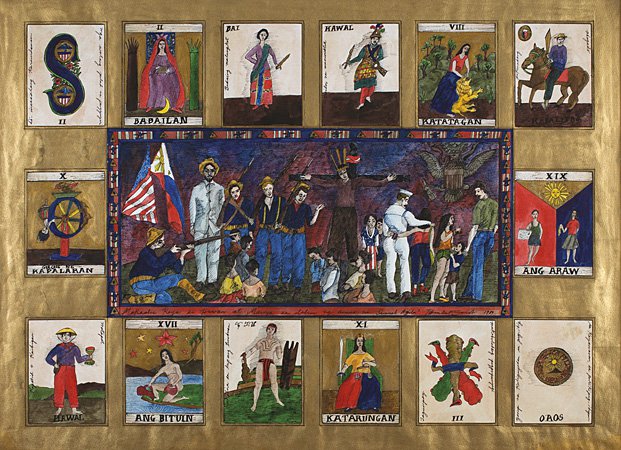Cultural Center of the Philippines
ENCYCLOPEDIA OF
PHILIPPINE ART
Tarot Series/Makaalis Kaya si Huwan at Mariya sa Ilalim ng Anino ni Samuel Agila?
1989 / Tempera and ink / 54 x 74 cm / Artist: Brenda Fajardo / Ateneo Art Gallery collection
The Tarot series by Fajardo, painter and printmaker, brings out historical and nationalist themes, along with folk and surrealist elements. In this particular painting of the series, the historical setting is in the early years of American colonization. The left side contains an allusion to the Philippine-American War, with the American soldier aiming his rifle at the crucified figure of a native Christ. At center, the civilian population of women and children are being subdued while, toward the right, the process of subjugation and moral corruption is completed with the woman dressed in the United States flag and the duo of the American marine and the prostitute below the emblem of the eagle. All around the horizontal image is a border consisting of tarot cards transposed into Philippine subjects, such as the babaylan or shaman and the figures of native Maranao and Ifugao warriors, a Katipunero (Katipunan member) soldier, a warrior on horseback, and a native lady, all dressed in colorful ethnic or historical costumes. Throughout the work are found allegorical figures representing Inang Bayan (Mother Country) as Justice and Stability, as well as symbols, seals, and flags of the two countries to convey conflict between, on the one hand, imperialist aggression and, on the other hand, the struggle for independence. The various figures of the native tarot represent the different forces and ideals playing a part in the historical process. Their juxtaposition may give rise to several insights about American hegemony in the Philippines.
The artist uses vivid folk colors enhanced with gold, as in medieval illuminations that the labels and lines of text also evoke. The figures themselves are done in a folk figurative style, implying an opposition to the dominant classical tradition.
Written by Alice G. Guillermo (1994)
